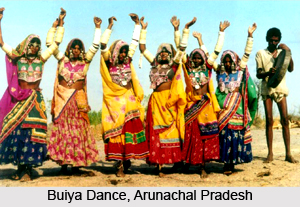 The Digaru Mishmis perform two types of dances, named as Buiya and Nuiya. The Buiya dance of Arunachal Pradesh has two types of movements and it is performed for entertainment while the Nuiya is a ritual-dance performed by a priest. The Buiya dance is performed on any festive occasion like the Duiya, Tazampu and Tanuya festivals. All such festivals are performed for the prosperity and good health of the performer and his household. This dance is also performed after a feast that is arranged by a family to entertain the fellow villagers. Both men and women perform the dance, in the passage that runs along, one side of the house from the front to the rear. Although, there is no age limit for performing this dance, children and old persons do not take active part in the dance, but instead are the spectators.
The Digaru Mishmis perform two types of dances, named as Buiya and Nuiya. The Buiya dance of Arunachal Pradesh has two types of movements and it is performed for entertainment while the Nuiya is a ritual-dance performed by a priest. The Buiya dance is performed on any festive occasion like the Duiya, Tazampu and Tanuya festivals. All such festivals are performed for the prosperity and good health of the performer and his household. This dance is also performed after a feast that is arranged by a family to entertain the fellow villagers. Both men and women perform the dance, in the passage that runs along, one side of the house from the front to the rear. Although, there is no age limit for performing this dance, children and old persons do not take active part in the dance, but instead are the spectators.
For the performance, there is no special costume or make up required, so the performer dances by wearing usual dresses. The males generally wear a loincloth, a sleeveless jacket, a turban and earrings, whereas, the females wear a blouse and a long skirt reaching down to the ankle. With this get-up, the women folk are seen with a side-bag on the left side. They also wear various ornaments like necklaces, large silver-ear-plugs and a silver fillet with its strap studded with coins or cowries, adding colour to the dance.
The dancers stand in a passage, forming a line one behind the other. One of the dancers plays on a drum while the other plays on a gong. Another dancer, depending upon the availability also plays cymbals. On these beats, the dancers perform various steps. In this, they take one step forward with the right foot, then gently bring the left foot up to the heel of the left one flexing the knees as before. With repetition of this sequence of movements, the dance is performed till it reaches to the rear of the passage. Thus, they dance up and down the passage of the house. When the dancers sing a song, it may be solo or in chorus. Generally, no movement is seen during the dance while skipping of steps is done but there is no accompanying song for the same. The skipping steps of the female dancers are comparatively lower and graceful while those of the male dancers are higher. At the time of a performance, the male dancers dance vigorously. However, there is no kind of remuneration given to the dancers. Similarly, there is no any formal training is given but they learn the dance movements by observing the performances by others.



















